
Ausangate Mountain is considered by the Quechua people to be one of the most holy mountains in all of the Andes. As a result, the 6-Day Ausangate Trek, while being a visually stunning adventure, is something of a spiritual pilgrimage. The Classic 4 Day Inca Trail is a more popular hike of the region, and for that reason more crowded and limited in availability. Ausangate is an off-the-beaten track hiking alternative with minimal foot traffic that allows you to carve into the mystical side of an ancient Andean world.
A voyage to Ausangate mountain is one of natural beauty, living history and ancient spirituality. Considered challenging, this 6 day trek is recommended for seasoned hikers only, who have experience hiking at high elevations. The route takes you through the Cordillera Vilcanota , or the Vilcanota Mountain Range. Ausangate is actually the 5th tallest mountain in Peru, standing at 20,945 feet above sea level.
Through this Peru trek, you’ll ascend and descend through the mountain range, finding sweeping Andean vistas, thermal lakes, mystical glaciers, green mossy passes and enormous snowy mountains. Along the way, you’ll catch a glimpse of interesting wildlife, like condors, chinchillas and groups of vicunas. You’ll also come across hidden Andean villages richly embedded in centuries-old traditions. The highest point of the trek is 16,800 feet above sea level and the highest campsite elevation is at 15,255 feet.
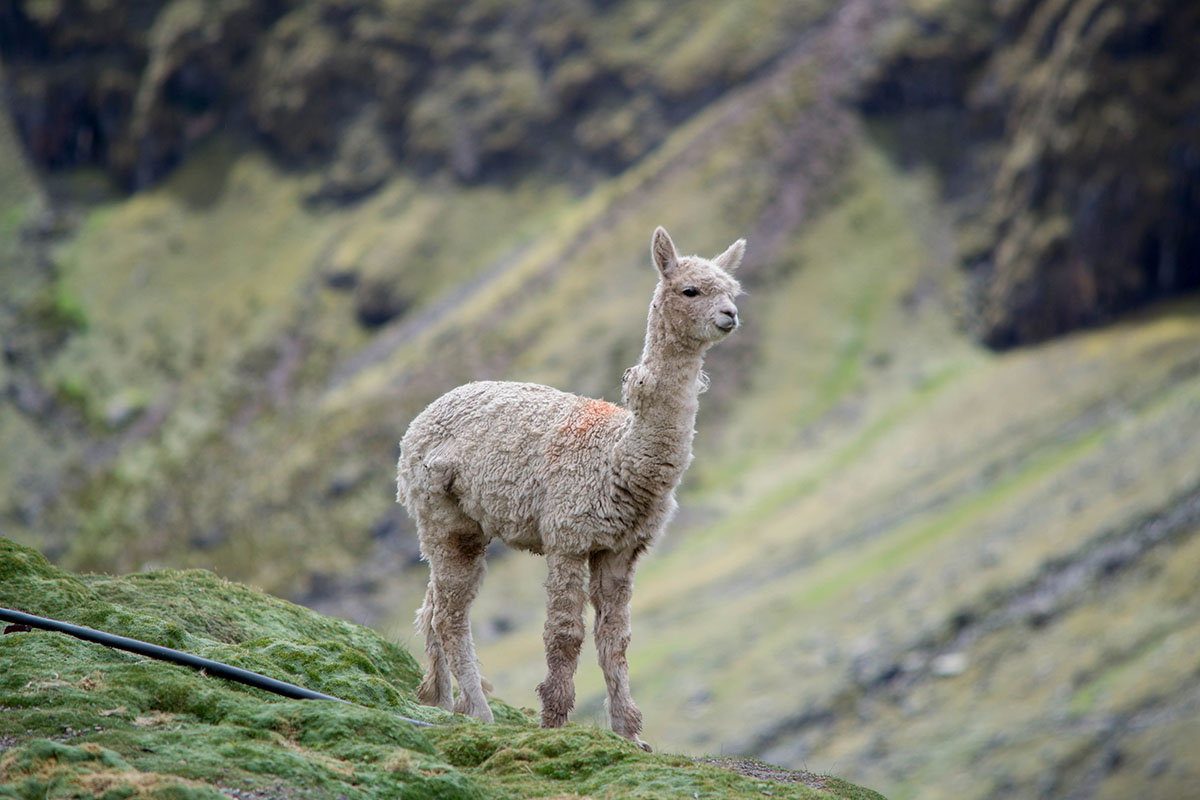
Alpaca traversing the Vilcanota Mountain Range along the Ausangate Trek. Image: Unsplash
In Andean spirituality, the mountains, called apus, are highly revered and believed to have a spirit. In fact, in Quechua apu means lord . These powerful spirits are believed to protect the local people in the highlands. Ausangate Mountain stands with 11 other sacred apus of the Cusco area, namely Salkantay, Mama Simona, Pillku Urqu, Manuel Pinta, Wanakawri, Pachatusan, Pikchu, Saksaywaman, Viraqochan, Pukin and Sinqa.
The road of the Apu Ausangate, or Ausangate Trek, is believed to be the most profound pilgrimage in the Andes and is one of the most renowned hikes in Peru. Traditionally, this spiritual journey is made during the Qoyllur Rit’i festival, a Quechua holiday that celebrates the stars in late May or early June (coinciding with the full moon). Specifically, it celebrates the reappearance of the Pleiades constellation in the night sky, marking the beginning of harvest season. The Ten Nations, or brotherhoods, of the surrounding areas all gather for the occasion.
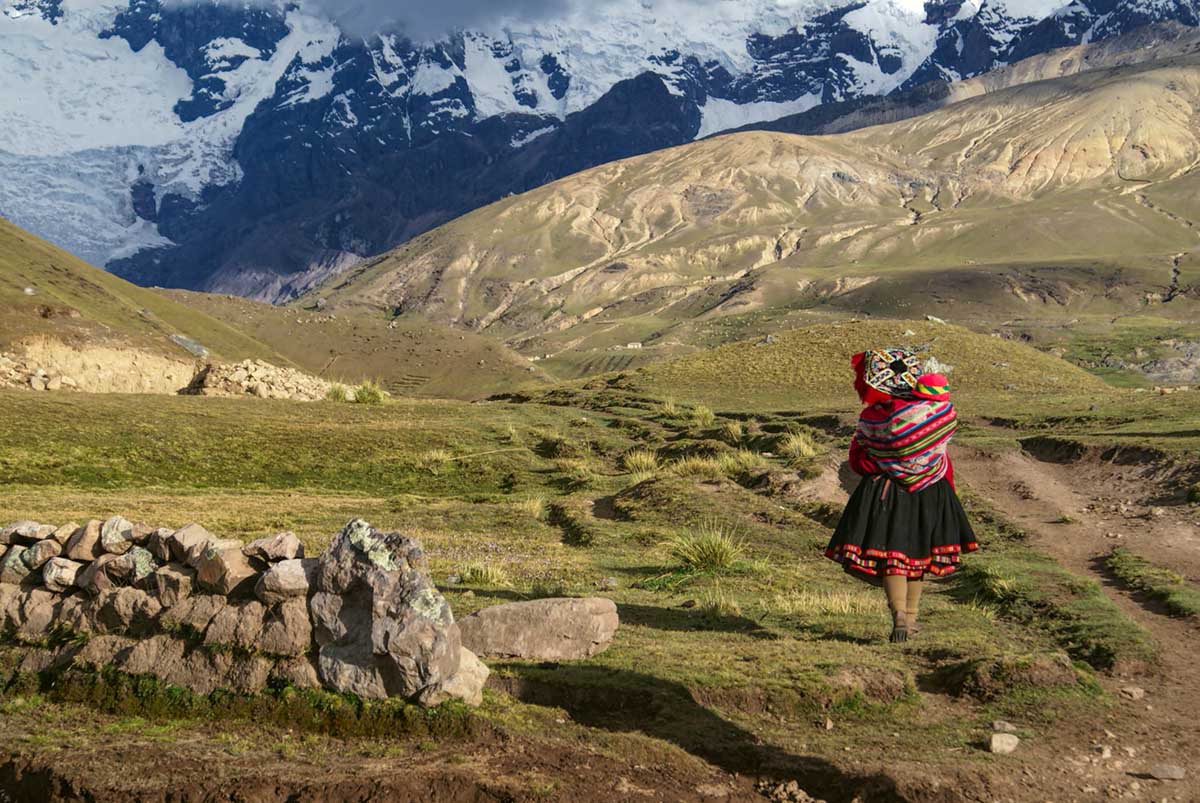
Andean woman walking in the Andes Mountains. Photo by Peru for Less.
The best time to do the Ausangate trek, and all Peru hiking tours, is between May and September. This is the dry season in the Andes, making for sunnier weather and clearer days to take in the beautiful scenery. Try particularly for July or August, the driest months of the year. The dry season is also the high season for the area, so Cusco , Machu Picchu and the Inca Trail tend to be more densely populated. Fortunately, the remote Ausangate Trek is a unique choice, making it clear of crowds year round – even during peak season.
The rainy season in the Andes is between October and April, with the rainiest months being January-March. During this time, especially in February, rain can be torrential, which may cause closures on the trail. It is best to stick to the dry season or the shoulder season (mixed weather) of April and October.
Trekking Tours:
The Ausangate trek is considered strenuous, with a few moderate days sprinkled in. The trek is classified as Grade C in difficulty, which implies altitudes between 14,800 to 16,400 ft (4500-5000 m) and 6-7 hours of hiking per day. Many of the days have steep sections that cause rapid altitude gain in a short time. Anyone with a good level of fitness can manage this hike, but it is recommended that trekkers have experience with multi-day hikes at high elevations.
Another factor to consider, aside from the steep sections and 16,000 ft+ elevation passes, is the weather. The weather can be quite unpredictable, and blizzard conditions at the higher altitudes are not uncommon. It is important to factor the low temperatures and your tolerance to cold and snow when determining your suitability for this trail.
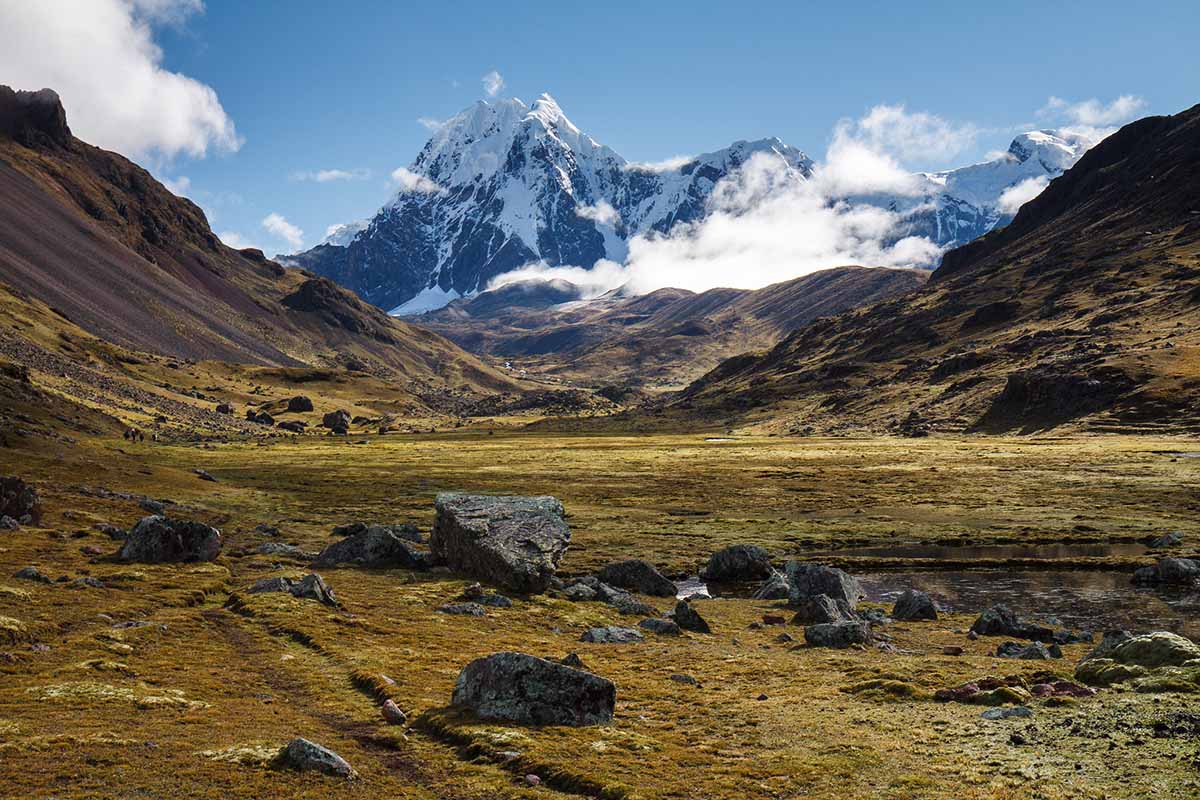
Valley leading to Ausangate Mountain. Image: Ausangate Landscape by Petr Meissner is licensed under CC BY 2.0
Only about 5 percent of hikers do this trek independently. It is only possible if you are a seasoned hiker who is acclimatized with the necessary gear and ample experience backpacking, hiking high elevations, and managing low temperatures/sometimes extreme weather conditions.
We recommend doing this trek with a guide. Between the experienced guides with rich regional knowledge, the traditional meals by local chefs, and the gear being carried and set up from campsite to campsite by local porters, a guided trip notably enhances the experience. Also, you’ll have more time and energy to focus more vividly on the adventure while also supporting the local economy and trek crew welfare.
Check out our Ausangate Trek tour for more information about inclusions for guided tours.
In the Vilcanota Range, there is a dry season and a wet season. The dry season is between May and September, and is considered the best time to hike in the Andes. Keep in mind, however, that the dry season, containing Peru’s winter months, is also the colder time of year. The coldest months are May through July. Expect the days to be cool, no warmer than 40 degrees F, and the nights to drop to freezing temperatures as low as 10 degrees F.
The rainy season is between October and April. While the rainy season is warmer, it can still be cool at night. In fact, there can be heavy snow as well given the elevation. The rain and snow can cause muddy conditions on the trail and even partial closures. It is especially inclimate between January-March, with February bringing the most precipitation. The shoulder months of October and April bring more moderate weather with mixed rainy and dry days.
The Ausangate hike traces through high elevation landscapes ranging between 10,334 ft to as high as 16,800 ft above sea level. The land surrounding the mountain features Andean uplift, glacial valleys with hanging glaciers, Permian formations and cretaceous limestone forests. The trail takes hikers through landscapes bursting with glaciers, snow capped mountains, thermal lakes, high flatlands and lush green valleys.
Traditionally, the 6 day Ausangate trek does not include connection to Machu Picchu . However, if you have extra time to spare, it can certainly be added on. Instead of ending day 6 at Tinki, you would continue on to Laguna Armaccocha, reach a viewpoint and lake Singrenacchocha on day 7, hike alongside the river to Mallma on day 8, and finally board a train to Aguas Calientes , the town at the base of Machu Picchu on day 9.

Machu Picchu. Photo by Ana Sotello of Peru for Less.
Another compelling aspect of the Ausangate trek is that you can conveniently arrange to do Rainbow Mountain as a side excursion. Rainbow Mountain, or Montaña de Siete Colores, is a very popular destination. Here you can see these iconic mountains with rich mineralization bringing red, orange and yellow hues across a seemingly endless mountain expanse. It’s truly a sight to behold.
This part of the trek would bring you to a soaring 17,060 feet above sea level. This portion also tends to be, by far, the busiest part of an otherwise remote journey. It is important to keep in mind the crowds and higher elevation (higher than any other point on the classic Ausangate) to decide if you’d like to add this portion to your Ausantage hike. Talk to a travel advisor for more information.
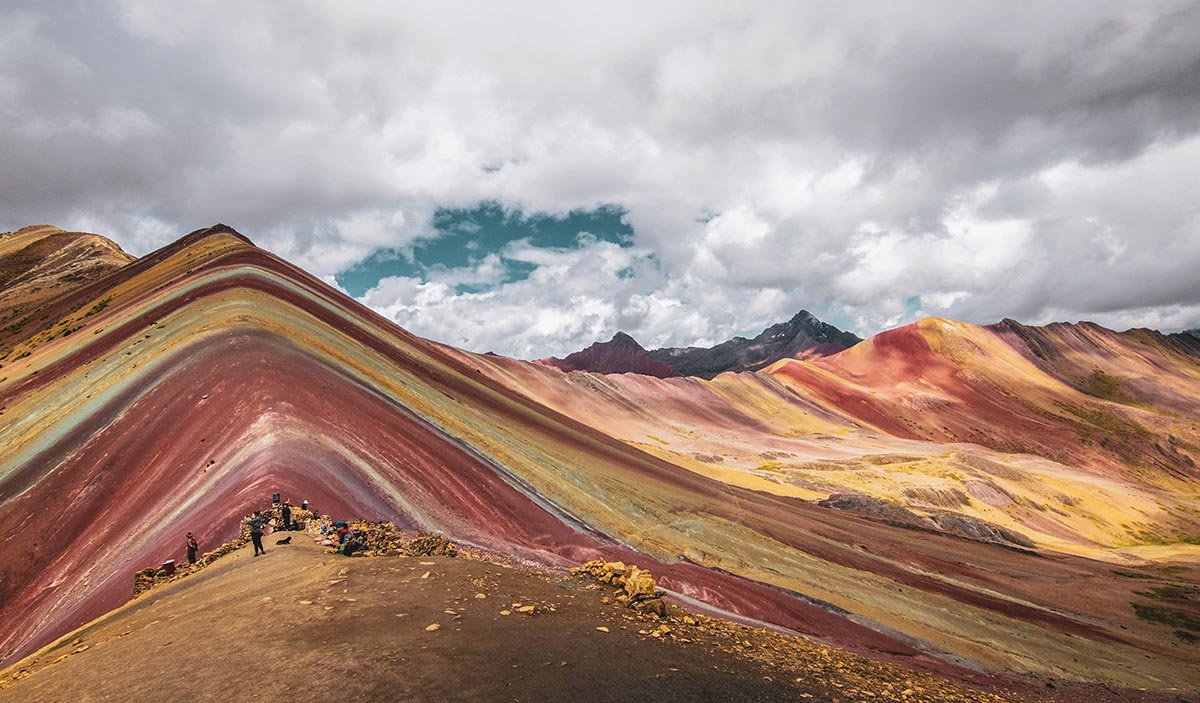
Rainbow Mountain. Image: Unsplash
Altitude sickness, or Acute Mountain Sickness (AMS), is a health effect that can arise at high elevations. Minor symptoms include headache, fatigue, difficulty sleeping and dizziness. More progressed cases can result in vomiting, shortness of breath and high altitude cerebral edema, which is associated with lethargy, nausea and disorientation.
Altitude sickness occurs in 20 percent of people at 8,000 feet and 40 percent of people at 10,000 feet. For a hike like the ausangate trek, it is highly likely that you will experience some form of altitude sickness, as elevations reach as high as 16,800 ft. For this reason, it is important to acclimate properly, take your time on the trail and take measures to combat symptoms.
Measures to combat acute mountain sickness include acclimatizing in the Andes for 48-72 hours, eating a light and high calorie diet, staying hydrated, avoiding smoking and alcohol, easing into the hike and taking breaks whenever necessary. You may also contact your healthcare provider for a recommendation for anti-altitude sickness medication as well. Another local remedy is chewing coca leaves, drinking coca tea or consuming coca candies – a traditional treatment for fighting AMS among the people of the Andes.
Machu Picchu Tours:
It’s best to pack lightly for Ausangate hiking. Generally hikers leave the bulk of their belongings safely in storage at their Cusco hotel , and bring only their hiking pack for the trek. This list ensures that you have everything you need for a guided trek without overburdening yourself.
Clothing
Footwear
Weather gear
Hiking gear
Electronics
Toiletries
Tipping is not mandatory on a guided Ausangate Trek, but it is highly recommended. You will be amazed by the amount of work and dedication that the guides, chefs, porters and other crew bring to your experience. Tipping is a great way to show your appreciation for the incredible experience. A good rule of thumb is 30-50 soles ($8-$15) per hiker per day. All the hikers on the team can pool their tips and then hand to the trekking team, who will distribute among themselves.
Below is a daily itinerary and highlight breakdown of the classic 6 Day Ausangate trek.
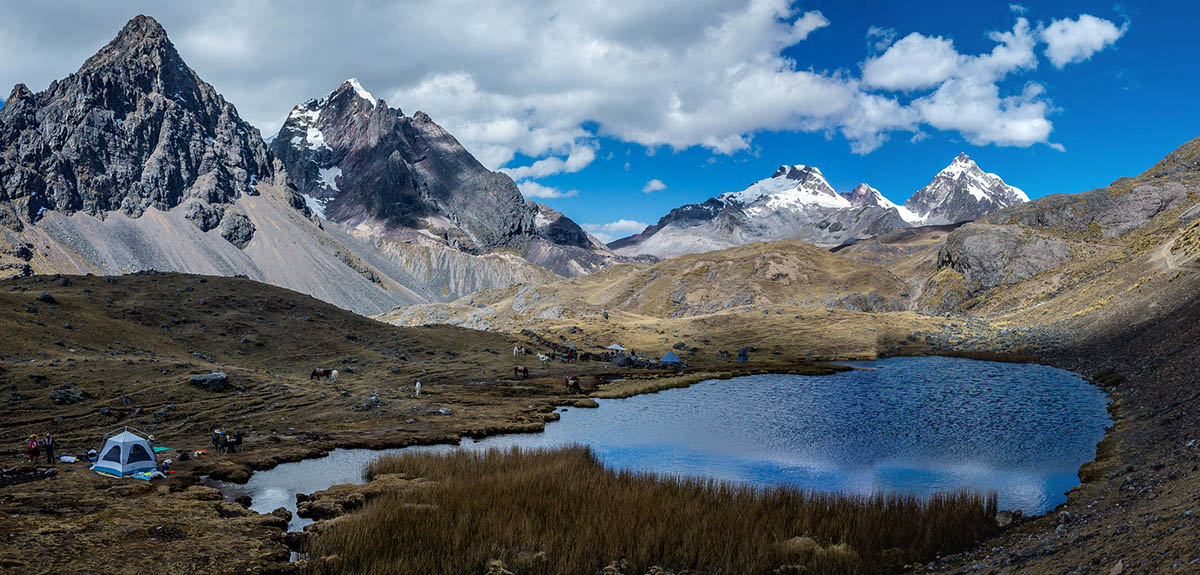
Campsite beside a lagoon on the Ausangate Trek. Image: Trekkers camping near a laguna in the majestic cordillera Vilcanota on the Ausangate circuit by sergejf is licensed under CC BY 2.0
Day 1 itinerary includes the archeological site of Tipon with its impressive water fountains, irrigation systems, and other marvels of pre-Columbian engineering. It then continues on to the ancient settlement of Pikillaqta, which was originally settled by the Wari culture. Later, you’ll continue on to the beautiful lake of Huacarpay and the town of Andahuaylillas with its famously decorated church, known as the Sistine Chapel of the Andes. Eventually your journey through this ancient landscape ends at the town of Tinki. Approximately 2-3 hours of hiking time.
Start by making your way to the camp of Upis. On the way, you’ll pass by the beautiful ecological landscape of Quinsapucyu and the mountain Huarmisaya. After lunch time, hikers have an opportunity to hike mystical thermal lakes and marvel at the uniqueness of its surrounding glaciers. Approximately 6-7 hours of hiking time.
Day 3 is the most challenging day of the trek. You’ll start on an increasingly steep trail that leads you up to a high mountain pass at Arapa where you will be rewarded with outstanding views of the entire mountain chain. After Arapa pass, you approach a series of beautiful Andean lakes. In the afternoon you’ll make another climb to the Ausangate pass before descending towards your campsite for the night at Ausangatecocha. Approximately 9 hours of hiking time.
Today, you begin your approach to the highest point of the trek, the pass at Abra Palomani. At this point you will be at a breathtaking 16,800 feet above sea level, enjoying unique views of the vast mountain chain that runs below you. From here you descend to the settlement of Huchuy Phinaya and continue on a gentler gradient through high flat land until reaching your campsite in the shadow of snow-capped Hatunpampa mountain. Approximately 9 hours of hiking time.
Starting out for another challenging day, your trail rises immediately towards the second high pass of Abra Janca, dominated by the peak of Colquecruz. From here it’s a gentle descent towards your lunch spot before you reach the town of Pacchanta where you’ll be rewarded with a dip in the town’s mineral rich thermal baths – a perfect chance to relax after a long, demanding day of hiking. Approximately 8 hours of hiking time.
Following the trail from Pacchanta, you eventually return to the town of Tinki, from where you began your adventure. You will celebrate the end of your epic Peru adventure trek with a pachamanca, a unique and ancient style of Andean cooking. Approximately 5 hours of hiking time.
See our Ausangate Trek page, where you can find more in depth information about the daily itinerary, inclusions for the trek, and high and low elevations of trail and campsites. You can also find a form to contact a travel advisor to perfectly tailor your ultimate Peru trekking adventure .
The Ausangate mountain trek, traversing one of the biggest mountains in all of Peru, is like a dream from start to finish. Between the high altitude naturescapes, the spiritual flourishes and the amazing local guides, it’s an adventure like no other. If you want to take to one of the lesser known trails of the mystical Andes, reach out to our team and we’ll be happy to include it in your upcoming Peru travel package .



Email: [email protected]
Sign up to receive our newsletter for great articles, stunning photos, and special deals.